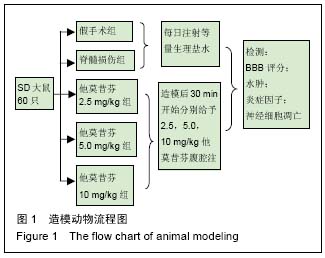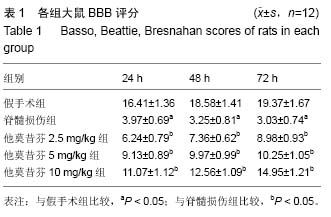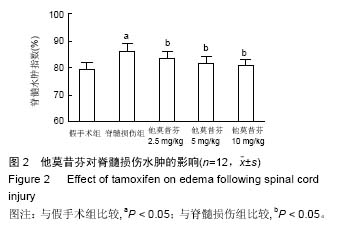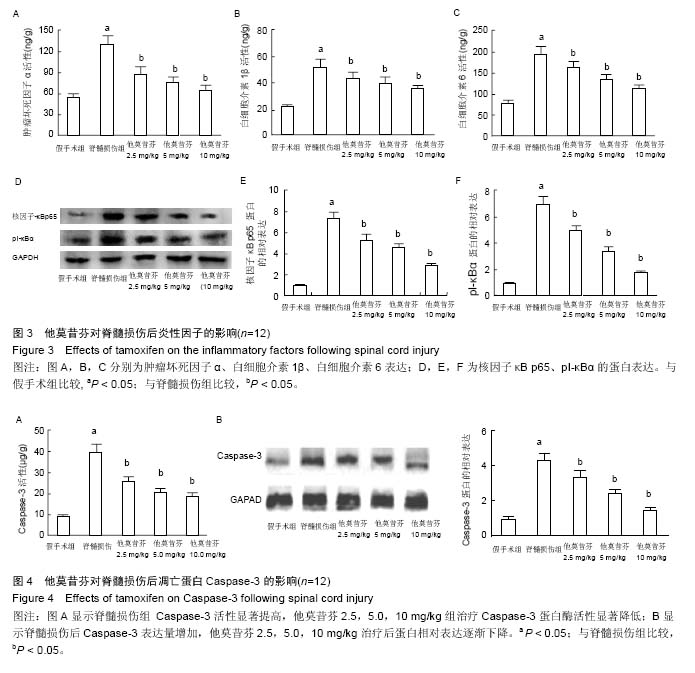| [1] Hausmann ON.Post-traumatic inflammation following spinal cord injury.Spinal Cord.2003;41(7):369-378.[2] Tettenborn B,Hägele-Link S.Spinal Cord Disorders.Eur Neurol.2015,74(3-4):141-146.[3] Kimelberg HK,Feustel PJ,Jin Y,et al.Acute treatment with tamoxifen reduces ischemic damage following middle cerebral artery occlusion.Neuroreport. 2000;11(12):2675-2679.[4] Kimelberg HK,Jin Y,Charniga C,et al.Neuroprotective activity of tamoxifen in permanent focal ischemia.J Neurosurg.2003;99(1):138-142.[5] 韦竑宇,梁立.他莫昔芬对大鼠脊髓损伤后炎性反应及细胞凋亡的影响[J].中国医药导报,2014,11(34):23-26.[6] Lan WB,Lin JH,Chen XW,et al.Overexpressing neuroglobin improves functional recovery by inhibiting neuronal apoptosis after spinal cord injury.Brain Res. 2014;1562:100-108.[7] Seo JY,Kim YH,Kim JW,et al.Effects of therapeutic hypothermia on apoptosis and autophagy after spinal cord injury in rats.Spine.2015,40(12):883-890.[8] Hagg T,Oudega M.Degenerative and spontaneous regenerative processes after spinal cord injury.J Neurotrauma.2006;23(3-4):264-280.[9] Jiang S,Bendjelloul F,Ballerini P,et al.Guanosine reduces apoptosis and inflammation associated with restoration of function in rats with acute spinal cord injury.Purinergic Signal.2007;3(4):411-421.[10] Choudhary GS,Al-Harbi S,Almasan A.Caspase-3 activation is a critical determinant of genotoxic stress-induced apoptosis.Methods Mol Biol.2015;1219:1-9.[11] Zhao J,Wang J,Wu J.Roles of cytochrome c,caspase-9, and caspase-3 in pentavalent vanadium-induced neuronalapoptosis.Zhonghua Lao Dong Wei Sheng Zhi Ye Bing Za Zhi.2014;32(9):664-667.[12] Ravikumar R,Fugaccia I,Scheff SW,et al.Nicotine attenuates morphological deficits in a contusion model of spinal cord injury.J Neurotrauma.2005;22(2): 240-251.[13] Basso DM,Beattie MS,Bresnahan JC,et al.MASCIS evaluation of open field locomotor scores:effects of experience and teamwork on reliability.J Neurotrauma.1996;13(7):343-359.[14] 熊春翔,宗少晖,曾高峰,等.大鼠Allen’s脊髓损伤模型的建立及评价[J].广西医科大学学报,2011,28(2):215-217.[15] Osuka K,Feustel PJ,Mongin AA,et al.Tamoxifen inhibits nitrotyrosine formation after reversible middle cerebral artery occlusion in the rat.J Neurochem. 2001; 76(6):1842-1850.[16] Suuronen T,Nuutinen T, Huuskonen J,et al. Anti-inflammatory effect of selective estrogen receptor modulators (SERMs) in microglial cells.Inflamm Res. 2005;54(5):194-203.[17] Salgado IK,Torrado AI,Santiago JM,et al.Tamoxifen and Src kinase inhibitors as neuroprotective/neuroregenerative drugs after spinal cord injury.Neural Regen Res.2015;10(3):385-390.[18] Yang T,Wu L,Wang H,et al.Inflammation level after decompression surgery for a rat model of chronic severe spinal cord compression and effects on ischemia-reperfusion injury.Neurol Med Chir.2015; 55(7):578-586.[19] Zhang N,Fang MR,Chen HH,et al.Evaluation of spinal cord injury animal models. Neural Regen Res. 2014;9 (22): 2008-2012.[20] Zhang Z,Zhang YP,Shields LB,et al.Technical comments on rodent spinal cord injuries models. Neural Regen Res. 2014;9 (5): 453-455.[21] Sun X,Ji C,Hu T,et al.Tamoxifen as an effective neuroprotectant against early brain injury and learning deficits induced by subarachnoid hemorrhage: possible involvement of inflammatory signaling.J Neuroinflammation.2013;10:157.[22] Campagnolo DI,Bartlett JA,Keller SE.Influence of neurological level on immune function following spinal cord injure:a review.J Spinal Cord Med.2000; 23(2): 121-128.[23] Cao XJ,Feng SQ,Fu CF,et al.Repair, protection and regeneration of spinal cord injury. Neural Regen Res. 2015;10(12): 1953-1975.[24] Xie JB,Zhang X,Li QH,et al.Inhibition of inflammatory cytokines after early decompression may mediate recovery of neurological function in rats with spinal cord injury. Neural Regen Res. 2015;10(2): 219-224.[25] Duo Z, He XJ.Advances in mechanisms of treatment for spinal cord injury with lithium.Zhongguo Gu Shang. 2015;28(7):679-682.[26] Cooney SJ,Zhao Y,Byrnes KR.Characterization of the expression and inflammatory activity of NADPH oxidase after spinal cord injury.Free Radic Res.2014; 48(8):929-939.[27] Khayrullina G,Bermudez S,Byrnes KR.Inhibition of NOX2 reduces locomotor impairment,inflammation, and oxidative stress after spinal cord injury.J Neuroinflammation.2015;12(1):172.[28] Kesani AK,Urquhart JC,Bedard N,et al.Systemic inflammatory response syndrome in patients with spinal cord injury: does its presence at admission affect patient outcomes?Clinical article.J Neurosurg Spine.2014;21(2):296-302.[29] Rathore KI,Redensek A,David S.Iron homeostasis in astrocytes and microglia is differentially regulated by TNF-αand TNF-β1.Glia.2012;60(5):738-750.[30] Jaworska A,Jamieson LE,Malek K,et al.SERS-based monitoring of the intracellular pH in endothelial cells: the influence of the extracellular environment and tumour necrosis factor-α.Analyst.2015;140(7):2321-9.[31] Lu M,Wang S,Han X,et al.Butein inhibits NF-κB activation and reduces infiltration of inflammatory cells and apoptosis after spinal cord injury in rats.Neurosci Lett.2013;542:87-91.[32] Han X,Lu M,Wang S,et al.Targeting IKK/NF-κB pathway reduces infiltration of inflammatory cells and apoptosis after spinal cord injury in rats. Neurosci Lett. 2012;511(1):28-32.[33] Henn IH,Bouman L,Schlehe JS,et al.Parkin mediates neuroprotection through activation of IkappaB kinase/nuclear factor-kappaB signaling.J Neurosci. 2007;27(8):1868-1878.[34] Wei HY,Ma X.Tamoxifen reduces infiltration of inflammatory cells,apoptosis and inhibits IKK/NF-κB pathway after spinal cord injury in rats.Neurol Sci.2014; 35(11):1763-1768. |
.jpg) 文题释义:
Allen’s法建立脊髓损伤模型:以一定力量撞击脊髓后造成脊髓水肿、缺血,并继发一系列损伤反应致脊髓损伤的典型表现,这种模型比较接近人类脊髓损伤的病理生理特点及变化规律。该法保持了硬脊膜完整,可有效防止外源性成分侵入脊髓损伤区域,并防止脊髓外露与脑脊液外漏。这种模型较接近人类脊髓损伤的病理生理特点及变化规律,对研究脊髓损伤后神经元、神经胶质细胞的病理变化、再生规律和相互作用、探索神经保护策略等有较大帮助。
他莫昔芬:用于治疗晚期乳腺癌和卵巢癌。临床治疗乳腺癌有效率一般在30%作用,雌激素受体阳性患者疗效较好(49%),阴性患者疗效差(7%)。绝经前和绝经后患者均可使用,而绝经后和60岁以上的人较绝经前和年轻患者的效果为好。从病灶部位来看,皮肤、淋巴结和软组织的疗效好,骨和内脏转移的效果差。
文题释义:
Allen’s法建立脊髓损伤模型:以一定力量撞击脊髓后造成脊髓水肿、缺血,并继发一系列损伤反应致脊髓损伤的典型表现,这种模型比较接近人类脊髓损伤的病理生理特点及变化规律。该法保持了硬脊膜完整,可有效防止外源性成分侵入脊髓损伤区域,并防止脊髓外露与脑脊液外漏。这种模型较接近人类脊髓损伤的病理生理特点及变化规律,对研究脊髓损伤后神经元、神经胶质细胞的病理变化、再生规律和相互作用、探索神经保护策略等有较大帮助。
他莫昔芬:用于治疗晚期乳腺癌和卵巢癌。临床治疗乳腺癌有效率一般在30%作用,雌激素受体阳性患者疗效较好(49%),阴性患者疗效差(7%)。绝经前和绝经后患者均可使用,而绝经后和60岁以上的人较绝经前和年轻患者的效果为好。从病灶部位来看,皮肤、淋巴结和软组织的疗效好,骨和内脏转移的效果差。.jpg) 文题释义:
Allen’s法建立脊髓损伤模型:以一定力量撞击脊髓后造成脊髓水肿、缺血,并继发一系列损伤反应致脊髓损伤的典型表现,这种模型比较接近人类脊髓损伤的病理生理特点及变化规律。该法保持了硬脊膜完整,可有效防止外源性成分侵入脊髓损伤区域,并防止脊髓外露与脑脊液外漏。这种模型较接近人类脊髓损伤的病理生理特点及变化规律,对研究脊髓损伤后神经元、神经胶质细胞的病理变化、再生规律和相互作用、探索神经保护策略等有较大帮助。
他莫昔芬:用于治疗晚期乳腺癌和卵巢癌。临床治疗乳腺癌有效率一般在30%作用,雌激素受体阳性患者疗效较好(49%),阴性患者疗效差(7%)。绝经前和绝经后患者均可使用,而绝经后和60岁以上的人较绝经前和年轻患者的效果为好。从病灶部位来看,皮肤、淋巴结和软组织的疗效好,骨和内脏转移的效果差。
文题释义:
Allen’s法建立脊髓损伤模型:以一定力量撞击脊髓后造成脊髓水肿、缺血,并继发一系列损伤反应致脊髓损伤的典型表现,这种模型比较接近人类脊髓损伤的病理生理特点及变化规律。该法保持了硬脊膜完整,可有效防止外源性成分侵入脊髓损伤区域,并防止脊髓外露与脑脊液外漏。这种模型较接近人类脊髓损伤的病理生理特点及变化规律,对研究脊髓损伤后神经元、神经胶质细胞的病理变化、再生规律和相互作用、探索神经保护策略等有较大帮助。
他莫昔芬:用于治疗晚期乳腺癌和卵巢癌。临床治疗乳腺癌有效率一般在30%作用,雌激素受体阳性患者疗效较好(49%),阴性患者疗效差(7%)。绝经前和绝经后患者均可使用,而绝经后和60岁以上的人较绝经前和年轻患者的效果为好。从病灶部位来看,皮肤、淋巴结和软组织的疗效好,骨和内脏转移的效果差。



.jpg) 文题释义:
Allen’s法建立脊髓损伤模型:以一定力量撞击脊髓后造成脊髓水肿、缺血,并继发一系列损伤反应致脊髓损伤的典型表现,这种模型比较接近人类脊髓损伤的病理生理特点及变化规律。该法保持了硬脊膜完整,可有效防止外源性成分侵入脊髓损伤区域,并防止脊髓外露与脑脊液外漏。这种模型较接近人类脊髓损伤的病理生理特点及变化规律,对研究脊髓损伤后神经元、神经胶质细胞的病理变化、再生规律和相互作用、探索神经保护策略等有较大帮助。
他莫昔芬:用于治疗晚期乳腺癌和卵巢癌。临床治疗乳腺癌有效率一般在30%作用,雌激素受体阳性患者疗效较好(49%),阴性患者疗效差(7%)。绝经前和绝经后患者均可使用,而绝经后和60岁以上的人较绝经前和年轻患者的效果为好。从病灶部位来看,皮肤、淋巴结和软组织的疗效好,骨和内脏转移的效果差。
文题释义:
Allen’s法建立脊髓损伤模型:以一定力量撞击脊髓后造成脊髓水肿、缺血,并继发一系列损伤反应致脊髓损伤的典型表现,这种模型比较接近人类脊髓损伤的病理生理特点及变化规律。该法保持了硬脊膜完整,可有效防止外源性成分侵入脊髓损伤区域,并防止脊髓外露与脑脊液外漏。这种模型较接近人类脊髓损伤的病理生理特点及变化规律,对研究脊髓损伤后神经元、神经胶质细胞的病理变化、再生规律和相互作用、探索神经保护策略等有较大帮助。
他莫昔芬:用于治疗晚期乳腺癌和卵巢癌。临床治疗乳腺癌有效率一般在30%作用,雌激素受体阳性患者疗效较好(49%),阴性患者疗效差(7%)。绝经前和绝经后患者均可使用,而绝经后和60岁以上的人较绝经前和年轻患者的效果为好。从病灶部位来看,皮肤、淋巴结和软组织的疗效好,骨和内脏转移的效果差。